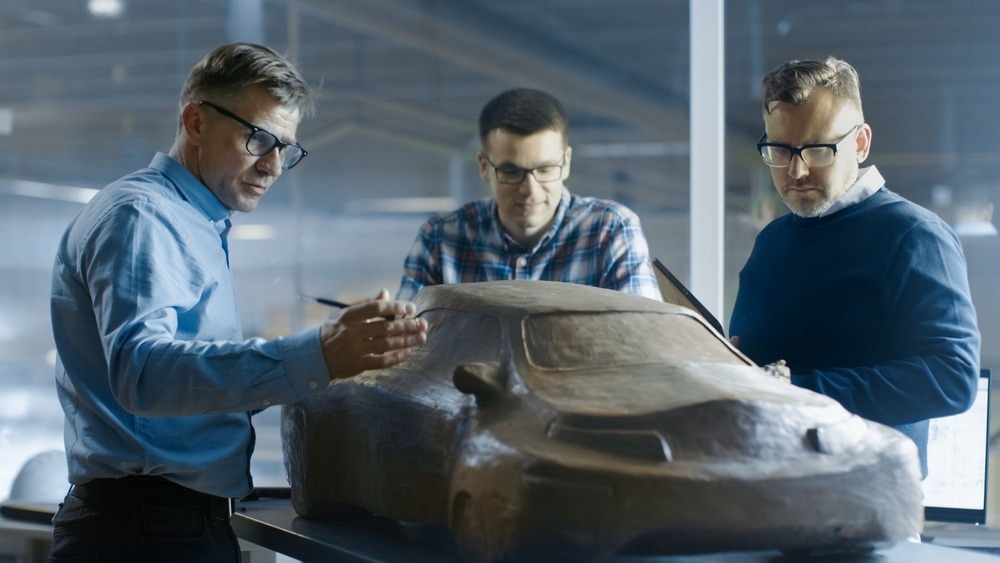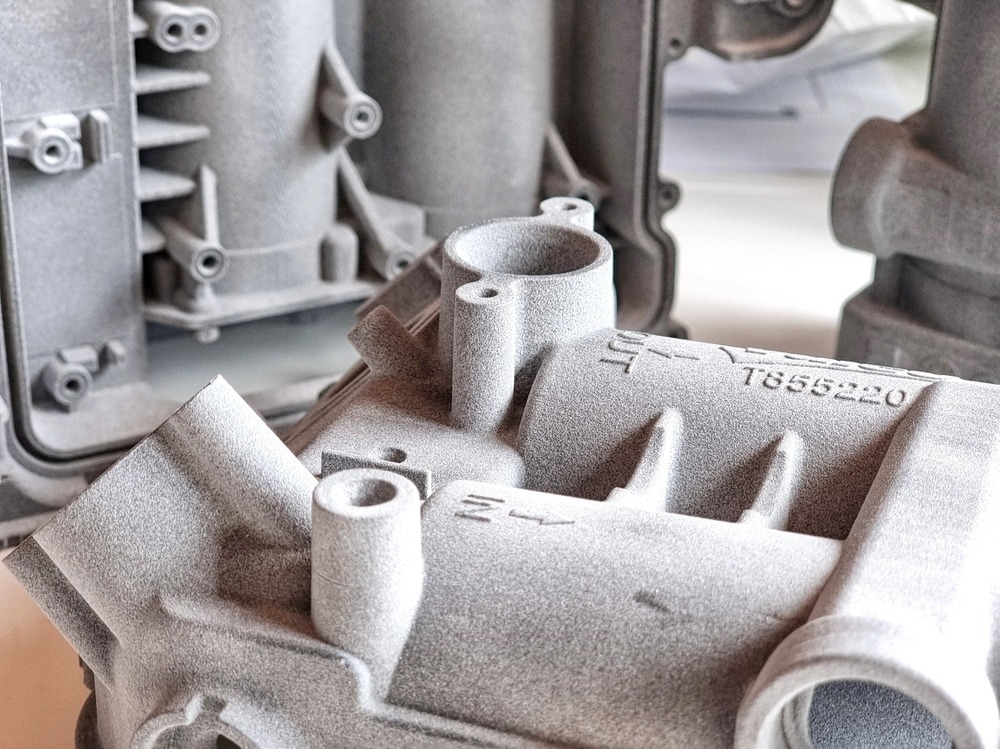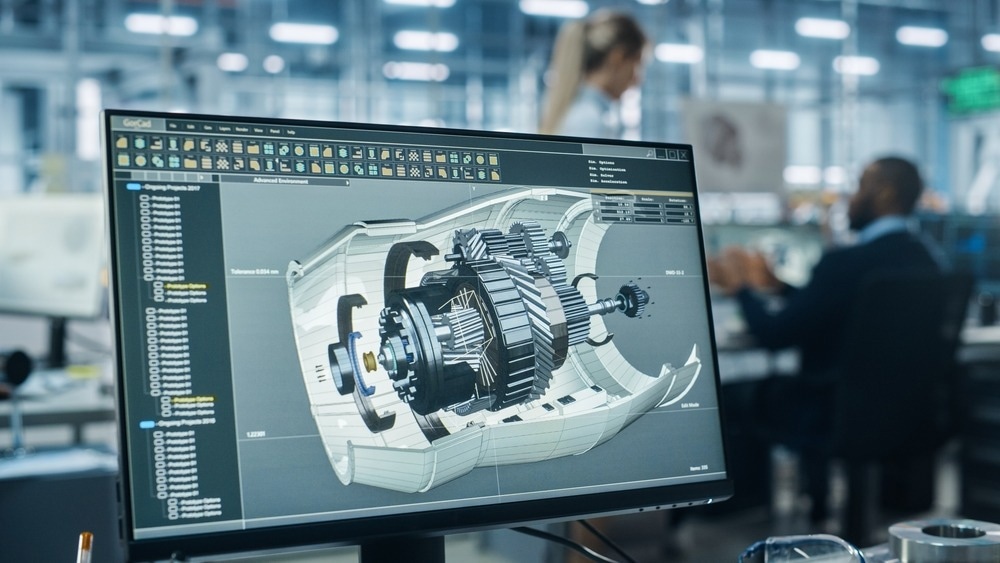In a world where rapid innovation drives progress, the automotive industry has found itself at a fascinating crossroads. Traditional methods of car design, once seen as the pinnacle of engineering artistry, are now being overtaken by digital counterparts. Standing tall at the helm of this digital revolution is the transformative technology of 3D Printing for Prototyping.

Image Credit: Gorodenkoff/Shutterstock.com
What exactly makes this technology the centrifugal force of modern automotive design? How is 3D Printing for Prototyping shaping the cars of tomorrow, and what tools make this possible? As we delve deep into the corridors of automotive evolution, we will explore the myriad ways 3D printing is not only influencing but redefining the entire spectrum of vehicle design and manufacturing. In this article, we embark on a journey to understand the symbiotic relationship between 3D printing and the ever-evolving world of automotive.
The Evolution of Automotive Prototyping
Automotive prototyping has witnessed a transformative journey, much like the vehicles it aims to design. This evolution has been a testament to the industry's relentless quest for perfection, pushing boundaries, and redefining the benchmarks of vehicular design.
The Dawn of Car Design: From Clay to CAD
The earliest days of car design were a tactile affair governed by skilled hands molding clay into sleek, aerodynamic shapes. These full-scale clay models, tangible and malleable, allowed designers to visualize, adjust, and reimagine vehicles before they hit the production line. It was an art form requiring immense skill and an eye for detail. However, as the world progressed into the digital age, so did the methods of car design. Computer-Aided Design (CAD) emerged as a groundbreaking tool, enabling designers to create intricate, detailed digital models with unmatched precision.

Image Credit: Gorodenkoff/Shutterstock.com
The transition from clay to CAD wasn't just about shifting mediums; it was a paradigm shift in design philosophy itself. With CAD, designers could experiment more, make quicker iterations, and visualize complex geometries that were difficult to achieve with clay.
Digital Transformation: The Role of Computer Simulations
With the rise of CAD, computer simulations became an indispensable part of the automotive design process. These simulations, powered by advanced algorithms and computational methods, allow designers to test various aspects of a vehicle's design in a virtual environment. From aerodynamics to crash tests, digital twins of car models undergo a battery of virtual tests to ensure they meet industry standards and safety requirements, while 3D Printing for Prototyping offers a tangible realization of these designs.
This digital transformation has not only sped up the design process but has also reduced costs. No longer did manufacturers need to produce expensive prototypes for every design iteration. Instead, most design flaws and potential improvements could be identified and rectified in the digital realm with 3D Printing for Prototyping, ensuring that only the most promising designs made it to the physical prototyping stage.
The 'Why' Behind the Use: Understanding the Need for 3D Printing in Automotive Prototyping
So, where does 3D printing fit into this evolving landscape? As automotive design became increasingly digital, the need for a bridge between the digital and physical worlds became evident. 3D Printing for Prototyping emerged as that bridge. 3D printing, with its ability to quickly transform digital designs into physical models, was a natural fit for the automotive industry. It offered a fast, efficient, and cost-effective way to produce prototypes, allowing designers to touch, feel, and test their creations in the real world. Moreover, 3D Printing for Prototyping facilitated iterative design, where feedback from one prototype could be quickly incorporated into the next version.
How It All Started: A Brief History
The foundations of 3D printing, or additive manufacturing, can be traced back to the 1980s. The early prototypes of 3D printers laid emphasis on a layer-by-layer approach, building objects from the ground up. Initially perceived as a niche tool for hobbyists and tech enthusiasts, its potential in industrial applications with 3D Printing for Prototyping soon became apparent.
In the automotive sphere, the introduction of 3D printing was nothing short of revolutionary. Where once car manufacturers depended on lengthy and often expensive traditional prototyping methods, they now had a tool that could produce parts quicker and often at a fraction of the cost. This was especially beneficial for producing complex and bespoke components that would be challenging or uneconomical with conventional manufacturing methods.
From Concept to Car: The Prototyping Journey with 3D Printing
The true allure of 3D printing lies in its capacity to turn vision into vehicular reality with unprecedented ease. Imagine a designer crafting a new car's blueprint. Within hours, this design can be fed into a 3D printer, and by the end of the day, a physical model is ready for inspection. This immediacy, provided by 3D Printing for Prototyping, allows for a swift feedback loop, where designs can be tweaked, adjusted, and reprinted in rapid succession. This accelerated prototyping journey has monumental implications. #
Car models can be brought to market faster, design flaws can be rectified promptly, and manufacturers can respond to market needs with agility. With 3D Printing for Prototyping, it also means that bespoke or limited-edition vehicles can be produced without the need for expensive moldings or tooling.
The 'How' of It: Techniques and Methodologies in 3D Printing for Automotive
3D printing in the automotive sector isn't a one-size-fits-all approach. With 3D Printing for Prototyping becoming more prevalent, there are multiple techniques and methodologies, each tailored to specific needs. Some of the most popular methods include:
• Stereolithography (SLA): This is one of the earliest techniques in 3D Printing for Prototyping and involves using a laser to solidify liquid resin layer by layer.
• Fused Deposition Modeling (FDM): In the realm of 3D Printing for Prototyping, FDM is a method where material is extruded through a heated nozzle, building the object layer by layer. It's particularly popular for producing larger parts.
• Selective Laser Sintering (SLS): A significant technique in 3D Printing for Prototyping, this method involves using a laser to fuse powdered materials, such as nylon or metal, into a solid structure. Given its capacity to produce high-strength parts, SLS finds substantial utility in automotive applications.
• Metal 3D Printing: In the context of 3D Printing for Prototyping, parts that require extreme strength and durability can be made using metal 3D printing. Techniques like Direct Metal Laser Sintering (DMLS) have been instrumental in crafting intricate metal components for high-performance vehicles.
The choice of technique largely depends on the purpose of the prototype, the desired material, and the required durability of the part. Regardless of the method, the essence remains consistent: 3D printing offers an unprecedented blend of speed, flexibility, and precision, cementing its position as a cornerstone in the future of automotive design and manufacturing.

Image Credit: Archiwo/Shutterstock.com
Digital Pioneers: Software Behind the Magic
Behind every sophisticated machine, there is a symphony of code and digital design that sets the stage for the tangible masterpiece. As 3D Printing for Prototyping emerges as a dominant force in automotive prototyping, the unsung heroes often reside in the binary world of software. These digital tools are not just facilitators; they are enablers, collaborators, and visionaries that breathe life into conceptual dreams.
CAD Software: Laying the Foundation
At the heart of any prototype made using 3D Printing for Prototyping lies Computer-Aided Design (CAD). CAD is the unsparing sketchpad of the digital age, allowing designers to craft intricate models with a degree of precision that manual sketches could never match. Popular software platforms like AutoCAD, SolidWorks, and CATIA empower designers to envisage and articulate complex geometries, mechanisms, and assemblies.
Not only does CAD software provide a visual blueprint, but it also enables functional simulations. Want to see how a particular door hinge operates or how airflow affects a new spoiler design? CAD offers a sandbox for these explorations, paving the way for improved design and functionality.
Collaborative Tech: The Interplay of Software in 3D Printing Realms
The bridge from CAD sketches to the final 3D print isn't crossed solo. A myriad of software platforms collaboratively ensures a design's viability for 3D printing. These synergies between CAD software giants and 3D printing champions are pivotal. By forging partnerships, companies like SolidWorks and Stratasys or Autodesk and MakerBot have set benchmarks for integration and compatibility, driving the printing process towards unparalleled efficiency and reliability. For instance, these tech alliances ensure designs birthed in distinct CAD spaces morph optimally for specialized 3D printers. This symbiosis not only uplifts the print's caliber but dramatically curtails errors and conserves resources.
From Digital Sketch to Tangible Form: The Role of Translation Tools
So, how does a digital vision manifest physically? The linchpin is translation utilities that morph CAD drafts into 3D printing lingua franca – predominantly the STL (stereolithography) format. Softwares like Meshmixer, TinkerCAD, and Cura are the vanguards in this transformative phase. They offer designers the dexterity to fine-tune their models, ensuring every intricate detail is 3D-printed to perfection. Whether adjusting resolution, bolstering structural robustness, or configuring supports for parts that defy gravity, these software act as the final gatekeepers before a concept becomes a reality.
Lifting the Veil: The Ascendancy of 3D Printing
In the automotive world's melodic dance of innovation, 3D printing has taken the limelight. As it assumes the main role, older methodologies retire backstage, witnessing the dawn of a groundbreaking design and production epoch. But what makes 3D printing for prototyping so universally acclaimed? Let’s journey through the facets that have thrust it into the spotlight.

Image Credit: Gorodenkoff/Shutterstock.com
Pacing Ahead: The Quest for Speed and Precision
In a realm where velocity dictates, both in design chambers and racing tracks, the need for brisk evolution is non-negotiable. While traditional prototyping tools were dependable, they were often snared by prolonged durations. Enter 3D printing, where time is an ally, not an obstacle. A blueprint conceptualized at sunrise can be tactile by dusk. Iterative processes, once spanning weeks, can now unfold within mere days. This nimbleness empowers automotive maestros to push the envelope, challenging norms and refining their masterpieces at a pace previously not thought of. 3D printing, in essence, turbocharges the voyage from ideation to tangible artistry.
Precision Engineering: Detailing Like Never Before
The devil, as they say, is in the details. 3D printing's ability to replicate intricate designs with microscopic accuracy showcases the power of 3D Printing for Prototyping. This technique is nothing short of a marvel. The layer-by-layer fabrication, a hallmark of 3D Printing for Prototyping, ensures that even the most complex geometries, often impossible with traditional manufacturing, come to life with surgical precision. Whether it's the fine lattice structures for lightweight components or the nuanced aerodynamic curves of a sports car, 3D Printing for Prototyping delivers unparalleled fidelity. This exactness not only enhances the aesthetic appeal but also optimizes functionality, giving manufacturers a competitive edge.
Sustainable Design: Green Manufacturing for a Blue Planet
Sustainability is not just a buzzword; it's an imperative. The automotive industry, often scrutinized for its environmental footprint, finds in 3D Printing for Prototyping a more eco-friendly ally. Additive manufacturing, by nature, is less wasteful. It only uses the material necessary for the part, significantly reducing scrap. Moreover, the flexibility of 3D Printing for Prototyping encourages the use of recycled or biodegradable materials. As the world shifts towards a more circular economy, this method stands poised to lead the charge in sustainable automotive production.
Financial Shifts: Cost Savings and Economic Implications
Money, as the lifeblood of business, finds a healthier flow with 3D Printing for Prototyping. The direct cost savings are evident. There's no need for expensive molds or toolings, reduced material wastage, and lessened dependency on large inventories. But the economic implications run deeper. The ability to produce on-demand with 3D Printing for Prototyping means less capital is tied up in stock. Customization, once a luxury reserved for the elite, becomes economically viable, opening new market segments. Moreover, as the technology becomes more accessible, even smaller manufacturers can embrace 3D Printing for Prototyping, democratizing the world of automotive design and production.
Facing the Hurdles: Limitations in the Landscape
While 3D Printing for Prototyping offers a world of possibilities in automotive design, it isn't without its challenges. Finding the perfect material for a specific application can be a tricky endeavor, as not all materials offer the right mix of durability and flexibility. Size poses another hurdle; while it's easy to print smaller parts using 3D Printing for Prototyping, creating larger components or entire vehicle frames remains a daunting task. Moreover, there's a balance to strike between intricate detailing and practical production: the more detailed a design, the harder it might be to produce feasibly. As promising as this method is, navigating these limitations is crucial for its optimal application in the automotive world.
Driving into the Future
As we cruise into the future of automotive prototyping, the horizon is lit with innovations. We're not just talking about advancements in 3D Printing for Prototyping, but also the exciting integration of Virtual Reality (VR) and Augmented Reality (AR) to visualize and refine designs. And then there's the budding concept of 4D printing—materials that can change and adapt over time, introducing a whole new dynamic to car manufacturing. The journey ahead is brimming with potential, and it's clear that the intersection of technology and imagination will continue to redefine the roads of tomorrow.
Collaborative Synergy: Partnerships Propelling Progress
In the dynamic realm of automotive innovation, collaboration has become the catalyst for groundbreaking advancements. It's a world where age-old automotive behemoths and nimble tech startups find common ground, embarking on a harmonious journey to reshape the industry. Through these partnerships, expertise merges, creating a fusion of traditional knowledge and fresh perspectives. A prime example of this synergy is the numerous successful 3D Printing for Prototyping collaborations. These alliances have resulted in faster prototyping, novel materials, and designs that were once deemed impossible. As case studies pile up, it's evident that the road to the future is paved not by singular giants, but by the collective strides of diverse collaborators.
Customization: Crafting Unique Automotive Experiences
In today's world, the car isn't just a mode of transport—it's an extension of one's personality. This evolving relationship between the driver and the drive has ignited a desire for personal touches, turning vehicles into unique canvases of expression. Personalization in Car Interiors Step inside a modern car, and you're not just entering a vehicle; you're entering a personalized sanctuary, thanks in part to 3D Printing for Prototyping. 3D printing is enabling intricate details that cater to individual tastes, from custom dashboard designs and ergonomic seat structures tailored for the driver, to ambient lighting and in-car accessories that echo a person's flair. These aren't mere aesthetic choices. They redefine comfort, ensuring that every journey feels as personal as the destination one is driving to.
Bespoke Exteriors: Crafting Distinct Road Identities
The exterior of a car is its first impression, and in an age of individuality, drivers want their vehicles to make a statement. With the capabilities of 3D Printing for Prototyping, drivers can achieve this. 3D printing facilitates this by allowing bespoke modifications—think personalized grill designs, unique alloy patterns, or even tailor-made body panels that stand out in a sea of generic designs.
3D Printing in Motorsports and Luxury Vehicles
In the high-octane world of motorsports, 3D Printing for Prototyping is revolutionizing how race cars are optimized, allowing teams to swiftly prototype parts tailored for specific tracks and conditions. This same technology is also making waves in the luxury car segment, offering unparalleled customization.
Conclusion
As we reflect on our expedition through the realm of 3D printing in the automotive sector, especially 3D Printing for Prototyping, it's evident that this technology has shifted gears from novelty to necessity. But the journey doesn't end here. The horizon hints at even more transformative possibilities. As we cruise forward, the roads of tomorrow seem filled with promise, potential, and uncharted adventures.
More from AZoM: How Automotive Industry Innovations are Driving Change
References and Further Reading
Gechev, T. (2022). A short review of 3D printing methods used in the automotive industry. [Online] Available at: https://www.researchgate.net/publication/357577691_A_short_review_of_3D_printing_methods_used_in_the_automotive_industry.
Cano-vicent, A. et al. (2021). Fused deposition modelling: Current status, methodology, applications, and future prospects. Additive Manufacturing.
Sreehitha, V. (2017). Impact of 3D Printing in Automobile Industries. International Journal of Mechanical and Production Engineering. [Online] Available at:
http://www.iraj.in/journal/journal_file/journal_pdf/2-347-149260399391-94.pdf
Manghnani, R. (2015). An Exploratory Study: The impact of Additive Manufacturing on the Automobile Industry. International Journal of Current Engineering and Technology. [Online] Available at:
http://inpressco.com/wp-content/uploads/2015/10/Paper563407-3410.pdf
Disclaimer: The views expressed here are those of the author expressed in their private capacity and do not necessarily represent the views of AZoM.com Limited T/A AZoNetwork the owner and operator of this website. This disclaimer forms part of the Terms and conditions of use of this website.